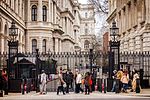Battle of Downing Street
1910 in British politics1910 in London1910 in women's historyDowning StreetFeminism and history ... and 7 more
Feminist protestsNovember 1910 eventsProtests in LondonUse Oxford spelling from June 2018Women's Social and Political UnionWomen's marchesWomen's suffrage in the United Kingdom

The Battle of Downing Street was a march of suffragettes to Downing Street, London, on 22 November 1910. Organized by Emmeline Pankhurst's Women's Social and Political Union, the march took place four days after Black Friday, a suffragette protest outside the House of Commons that saw the women violently attacked by police.
Excerpt from the Wikipedia article Battle of Downing Street (License: CC BY-SA 3.0, Authors, Images).Battle of Downing Street
Downing Street, City of Westminster Lambeth
Geographical coordinates (GPS) Address Website Nearby Places Show on map
Geographical coordinates (GPS)
| Latitude | Longitude |
|---|---|
| N 51.503222222222 ° | E -0.1275 ° |
Address
Prime Minister’s Office
Downing Street 10
SW1A 2AA City of Westminster, Lambeth
England, United Kingdom
Open on Google Maps










